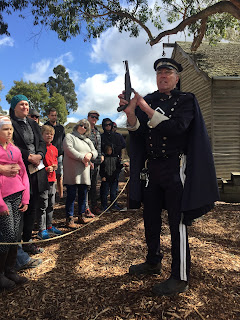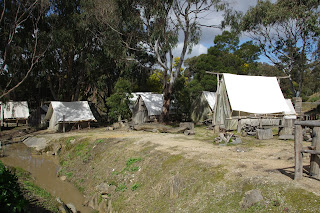Sovereign Hill was one of the gold mining sections that created Ballarat. I found it interesting that the governor of Victoria actually started a contest to find gold in his state to counter the emigration of Victorians to New South Wales and Queensland to search for gold. The contest was successful and gold was discovered in the Ballarat area. With the discovery men flocked to the region creating a boom town that today has over 100,000 people. We stopped here for one night on our trip 20 years ago so when we found that Worldmark had a place for us here, we could not pass it up.
Gold was discovered in 1851 and soon became the richest alluvial gold find ever in the world, a distinction it still holds today. Today’s park opened in 1970 on a 25 hectare plot that recreates the first ten years of Ballarat’s existence with recreated buildings, demonstrations of the processes involved in gold mining and productions, and reenactors who play the roles of the various residents of the growing metropolis. Today it employs over 400 full-time and casual workers along with a larger number of volunteers, most of whom fill in the roles of townspeople like the three elderly women we encountered doing their knitting and chatting amongst themselves in one of the hotels. They were happy to spend a few minutes of their day chatting with us, too. Another of the volunteers told us he used to work there full time until he found a better job. Now he volunteers one day a month running the boilers and doing a demonstration of the battery because he loves working with steam-powered machines. At home he even has his own small boiler to power the equipment he has built and restored.
 |
| Panning for gold - for real |
Demonstrations we watched included a muzzle loader being fired, the boiler, a blacksmith, and gold pouring. The muzzle loading demonstration included a talk on the history of the town and the development of democracy. Early miners were subjected to a hefty license fee even when they weren’t producing any gold. They were also faced with a police force that included some of the worst criminals who had been transported from England and then pardoned. The police were paid through the fines they collected. They earned 20% of every fine they levied, an obvious incentive for corruption. When the miners protested and built a ‘stockade’ for protection, they were attacked by the military. The battle of Eureka lasted about 20 minutes with 30 deaths, 18 miners and 8 soldiers. The leaders of the protest were tried for treason and quickly acquitted by the juries. The end result was that the miners won all their points including the right of every man in the state to vote, the first place in the world with such a wide suffrage. The site of the battle is today the Museum of Democracy which shows the pride that Ballarat still shows in their role in the beginnings of a true democracy.
 |
| Shooting demonstrated included a history of Ballarat |
Reenactors add to the fun of the place. We watched an altercation between a newly rich miner and a local well-to-do. The miner was showing off his new girlfriend as the local was berating him and her as nouveau riche who would soon lose everything and still be a worthless human being. It’s hard to predict the future, but it is probably true that his new girlfriend was probably a better gold miner than he was. We also joined the crowd at the theatre where we saw a rather risque dancer who actually show her petticoats and ankles. At the end of her performance she was attacked by one of the town’s real ladies for lowering the morals of the town.
 |
| Verbal fighting, no fisticuffs |
 |
| We think she was the real gold digger |
 |
| Chinese camp |
 |
| Showing way too much |
 |
| Pouring gold ten times a day |
 |
| Mayor's necklace of gold |
 |
| Early transportation |












No comments:
Post a Comment